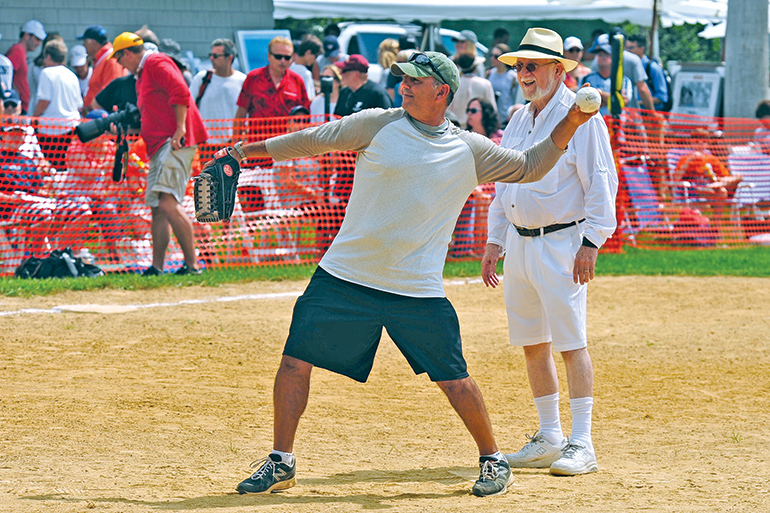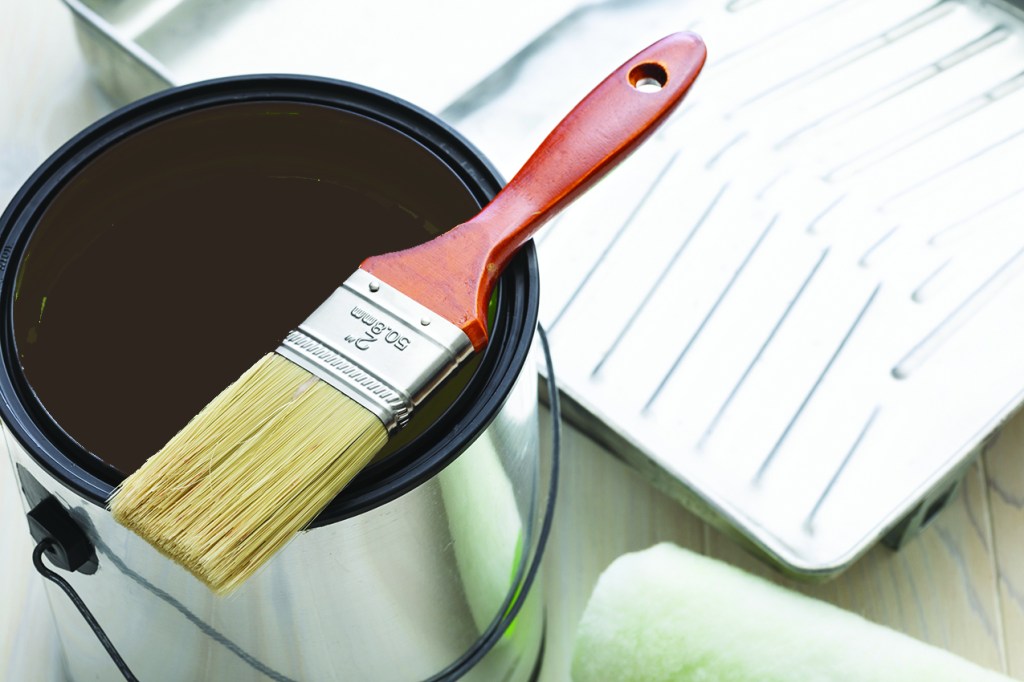Artists & Writers Softball Game: A History from 1948–2018

What do all these nationally and internationally known people past and present have in common?
Cleveland Mayor Carl Stokes, Supreme Court Justice Stephen Breyer, heavyweight prizefight contender Gerry Cooney, soccer star Pelé, Mayor Rudy Giuliani, lifestyle star Martha Stewart, New York Jets defensive lineman Marty Lyons and baseball great Yogi Berra.
Also, actors Alan Alda, Lauren Bacall, Alec Baldwin, Tony Randall, Peter Boyle, Matthew Broderick, Chevy Chase, Dustin Hoffman, Mercedes Ruehl, Roy Scheider, Gwen Verdon, editor Ben Bradlee, model Christie Brinkley, TV personalities Dick Cavett, Dr. Ruth, Peter Jennings, Regis Philbin, cartoonist Jules Feiffer, art dealer Leo Castilli, President Bill Clinton, presidential candidates Barry Commoner and Eugene McCarthy, painters Willem de Kooning, Jackson Pollock, Eric and Jimmy Ernst and hockey player Rod Gilbert.
Also authors E.L. Doctorow, Joe Heller, Peter Maas, Jay McInerney, Irwin Shaw, Kurt Vonnegut, Peter Matthiessen, Tom Wolfe, activists Betty Friedan and Abbie Hoffman, businessman Carl Icahn, Howard Stringer, singers Eartha Kitt, Tom Paxton, Paul Simon, TV legend Norman Lear, Broadway personalities Neil Simon and Eli Wallach.
What they all have in common is that each and every one has participated in the Artists & Writers Charity Softball Game, played once every summer in East Hampton on the sandlot ball field in Herrick Park behind the Stop & Shop supermarket. This year’s game, open to the public, is at a new time—4 p.m.—on Saturday August 18.
Don’t know where Herrick Park is? Look for the big banner crossing Newtown Lane advertising the game for the days leading up to it. The game is behind the stores to the west of the banner. And who knows who will show up for this year’s encounter?
In the summer of 1948, some painters gathered in Springs for an annual family picnic and baseball game in the back yard of Wilfrid Zogbaum’s home. Nobody kept score. But Willem de Kooning, Jackson Pollock, Franz Kline, Philip Pavia, Howard Kanovitz, Syd Solomon and Joan Mitchell played ball and laughed and yelled and had a good time. And that was the first game.
Back in those days, painters and sculptors from the city came out by the dozens to live on the cheap in the Hamptons among the peace and quiet of the farmers and fishermen. Many were in the vanguard of the new Abstract Expressionist movement, an approach to painting eagerly accepted throughout the world. Paris had been the accepted center of the art world for many years. Post-war, it was Manhattan and then, for that one decade, Springs. The painters and sculptures worked in barns and out buildings which they converted to studios.
Soon, writers joined in to play in the annual game. It started with art critic Harold Rosenberg from The New York Times and book publisher Barney Rosset. Then came novelists. James Jones, Irwin Shaw, George Plimpton, Joe Heller and Peter Matthiessen all played. “They wanted to keep score,” one of the artists at that time said ruefully. Thus the game, formerly sloppy and informal, was organized.

In the 1960s and early 1970s, a revolutionary counter-culture movement swept the country, resulting in many new writers appearing on the scene, some of whom played in this softball game. Among them were authors with books and political positions far to the left.
One year, hippie Abbie Hoffman came to the plate to hit for the Writers. He took a strike, then a ball and on the next pitch and, without swinging, he ran down and claimed first base. It seemed appropriate. He had just written Steal this Book, which was available at bookstores. Betty Friedan played. She had just written The Feminine Mystique, which launched the feminist movement.
Artists playing included Jim Dine, Kyle Morris, Ray Parker, Warren Brandt, Esteban Vicente, Norman Bluhm, Ben Heller, Bill King, Larry Rivers, Herman Cherry and Howard Kanovitz. Writers included Terry Southern, David Myers, Arthur Blaustein and Jerry Leiber.
In 1968, Senator Eugene McCarthy of Wisconsin had challenged the sitting president, Lyndon Johnson, in the primary, polling so close to upsetting him that Johnson withdrew from the fray. Money raised at the game was sent to McCarthy’s election campaign, but then he didn’t get nominated. The next year, McCarthy attended the game, playing first base. I recall him wearing shorts and a t-shirt, scurrying through the dust. Sometime during the game, the seam at the back of his shorts split. Didn’t seem to affect his performance, though.
Singer Paul Simon played in the 1970s. He was small, fast and very athletic. At one game, in left field, he drifted back to the wall—which was a four-foot-high snow fence—leaped up to catch the ball, and came down hard on top of the pickets. Everyone held their breaths. But, amazingly, he was not injured. Folk singer Tom Paxton played during the 1970s too.
My interest in the game began in 1968. I played for the Writers. Dan’s Papers had been in business eight years. This was a spectacular, well-played, hilarious and goofy game. I decided to document it. That year, the Writers won 21–2. They won 9 games of the next 10. Why? Nobody ever knew, though many scribes struggled to explain the phenomena. It was a cosmic question.
In 1969, I received, second-hand, the prize for Player of the Game. Every year, after the game ended, the players, all dirt- and dust-covered, would repair to Leif Hope’s Laundry restaurant for cold beer and good times. There, Leif would announce the “Player of the Game.” I don’t remember who it was that won player of the game that year but it wasn’t me. I wasn’t good enough to have won it. Also, I was a rookie for the writers.
At the end of that party, Leif told me the guy who won had not shown up, and they had a jeroboam of white wine they had intended to give him. Would I take it? I did. It was an enormous bottle, maybe five gallons. I dragged it home. It was a good month before I had a party at my house large enough to crack open the jeroboam and finish it. The “Player of the Game” award, I told people. The following year I got traded to the Artists. I objected. Gallery owner Elaine Benson insisted. So I went. The next year, I became the balls-and-strikes umpire behind the pitcher’s mound. I’ve been doing that to this day.
In 1976, John Leo organized a weekly softball game during the summer in Mashashaimuet Park in Sag Harbor. It’s still going. Many who play in that weekly game continue to play at the Artists & Writers game. One wag at the Artists & Writers referred to it as “Triple-A Ball,” the minor league for the big annual game in East Hampton.
The New York Times did a story about the game that year. As a result, TV and magazine people began reporting on the game. And celebrities began to play in it, mostly on the Artist’s side. They were “Artists.” And for the most part, they were lousy ballplayers. The drubbing by the Writers continued year after year. By this time, Leif Hope, an artist who everyone admired, stepped up and took charge of the game—he is still in charge—and soon tried to even things up by bringing several professional women’s baseball players from Connecticut, who mowed down the writers one, two, three.
But they were allowed only one inning. When the Writers complained, Hope noted that the Writers had started expanding the definition of Artists and Writers by bringing in lawyers who “wrote” legal briefs and agents (such as Sam Cohn) who “wrote” contracts. The writers were still on their winning streak. As a result, Leif began to bring in real sluggers. Perhaps the best of them was Marty Lyons, a professional football defensive tackle for the New York Jets who, as it happened, one year hit a home run not into the tennis court beyond left field, but over it—the longest home run on record in the game. He’d been in movies. So he was an Artist.
Another big, strong, beefy guy who played in the game for several years was heavyweight boxing contender Gerry Cooney. In the 1996 game, Cooney was playing second when a batter singled to left. Andrew Lack, the President of NBC News, was on first when the ball cleared the infield and Lack took off for second and slammed into Cooney just standing there. He didn’t even have the ball. Lack bounced off Cooney, fell to the ground and didn’t get up. People had to come out and revive him. They helped him off.
During this period, Leif would have me start as umpire of the game, but then after two or three innings hand the ball over to a “guest” umpire for the next few innings. In 1992, he had me hand the ball over to the Governor of Arkansas. I asked what the hell is the Governor of Arkansas doing at our game? He shrugged. Thus it was I told Bill Clinton, who I did not know, that if he needed help in the rules department, I’d be over on third base. He needed no help. For two years, Mayor Giuliani was my “guest” umpire. He needed no help, either.
We did have umpires not only behind the mound (me), but also down the line at first and third. When Andrew Lack ran into Gerry Cooney and had to be helped off the field, I got into an argument with Supreme Court Judge Stephen Breyer, who was coaching first. An Artist had tossed the ball to the first baseman, thus “picking off” Lack, and Breyer declared Lack out. But I overruled it.

I really enjoyed being umpire. Still do. I recall deliciously watching Carl Icahn holding the bat on his shoulder while I called him out for not even swinging at strike three. Christie Brinkley batted and someone shouted after strike three to give her strike four, and I did. She still didn’t hit it. The next pitch resulted in a short bouncer to the infield and a throw to first in time.
In 1976, more women clamored to play. That year, food critic Florence Fabricant and Susan Ringo, Sara Compton, Linda George, Beverly Schanzer and Nancy Kelley played. The Writers won 5–4.
As pure sport, the game often had exciting moments. In the 1975 game, Carl Stokes, former Mayor of Cleveland, hit an into-the-tennis-court home run. Trotting home, he accidentally ran down catcher Howard Kanovitz, knocking off his mask and cutting his nose. What a wild melee that game was, the Writers winning it 14–12.
In the 1980s, Englishman Howard Stringer and PR legend John Scanlon did the play-by-play over the microphone behind the backstop, in hilarious fashion. Ken Auletta came up to the plate. “Few people know this, but Ken Auletta wrote the Complete Works of Shakespeare,” said Scanlon. “He himself doesn’t even know he did this, which is even more remarkable.”
John Leo wrote an essay about the game, published on the Artists & Writers website awgame.org and had this to say about John Scanlon:
“John Scanlon, the play-by-play announcer for several years, had a couple of weaknesses in trying to fill that job: he never bothered to learn the names of the Artists, and he had trouble understanding why the game needed any artists at all. When these people worked, if you could call it that, they didn’t even use words! So if an artist was coming to bat, Scanlon might announce: ‘Here comes Petrillo the artist (heh, heh). He paints landscapes. No, wait. I think he paints houses. I’ll have to check.’ So poor Petrillo, who was probably some sort of master of abstract digital video, had to try concentrating on batting while Scanlon would be cackling away about how many houses Petrillo had painted in the Hamptons, cheap too, and how he is thinking of branching out into Hummel-making, though his wife thinks that might be a bit risky, with a smaller profit-margin and all.”
One year, the game, which had been scheduled for 2 p.m., was delayed an hour. Some teenagers had reserved the field to play a game of Ultimate Frisbee, so the Artists & Writers Game had to wait.
Perhaps the most exciting play of any of the Artists & Writers games occurred the year when Superman won the game for the Artists in the bottom of the ninth.
The game was tied, 6–6. There were two out and the late Christopher Reeve (Superman in the movies) was on second. Paul Simon hit a single through the hole into left field, Reeve took off, rounded third and headed for home to beat the throw coming in from left fielder Uri Berliner, which seemed sure to get him.
At home waiting for the ball was catcher Roger Podd and pitcher Mort Zuckerman, who had drifted over even though this was not his play, but when the two saw Superman go into his slide, they were still juggling the ball and so missed the tag. But Superman, sliding around them, had missed the plate. He knew it, so he leaped up, ran over and stomped back onto the plate safe for the win.
The 1990s drew crowds in excess of a thousand to watch the game. The game also had begun to have sponsors, who paid to be there—all funds going to charity. The most notable sponsor was Snapple, whose 12-foot inflatable juice drink waved drunkenly beyond the fence in center field when the wind sprang up.
George Plimpton, Ken Auletta, Richard Reeves and Ben Bradlee played for the Writers in 1990. Sam Robards played. His mom, Lauren Bacall, called out raffle tickets. Ed Tivnan was Player of the Game.
In 1991, players included Dennis Lawrence (game MVP), Jeff Meizlik, Stu Sleppin, Roy Scheider, Regis Philbin, Lori Singer, Dick Cavett and Peter Boyle. And the Writers won again.
Chevy Chase and Alec Baldwin played in 1992. Jay McInerney was the game MVP in 1993. A crowd estimated at 3,000 attended the game in 1994. Movie producer Ed Burns hit three home runs in 1995.
After the turn of the new century, the game morphed into a real family day for spectators, with hot dogs and burgers available and game paraphernalia for sale. Three years ago, the game brought in more than $100,000 for four local charities—East End Hospice, the Retreat, Phoenix House Academy and the Eleanor Whitmore Early Childhood Center.
And the game has carried on, with Leif Hope now essentially the Commissioner of Softball. Huge home runs have been hit by Rick Wiese, director of the Explorers Club, artist Tom Clohessy, Jeff Hilford, Ed Hollander, Eddie McCarthy, Jeffrey Meizlik and others, though none have matched Marty Lyons’s earlier blast. President Bill Clinton came to the game again in 2012, and boxing writer Burt Sugar and James Lipton of Inside the Actors Studio served as announcers. In 2008, Chief of Police Gerry Larsen played.
Why? Well, the mayor introduces the game at the start of festivities, so why not? “He wanted to play, what am I going to do?” Leif said. In 2009, Rangers hockey star Rod Gilbert umpired. And Watergate journalist Carl Bernstein played behind the plate. In 2011, New York Yankees legend Jim Leyritz played. Mark Feuerstein of Royal Pains was the Rookie of the Year in 2012.
Some nights, I wake up at 3 a.m. and remember a particular play that I might have called wrong.
The Writers were up by a run. There were two outs in the bottom of the ninth. The batter hit a fading foul ball high over the crowd sitting in the grass in foul territory along the first base line, and George Plimpton, playing first base for the Writers, stepped into the crowd to catch it. Stepping between people, he unfortunately stepped in the grass just next to actress Lori Singer, a player for the Artists, who pushed at his leg, causing him to drop the ball.
Foul ball, I called. It cleared the benches. “Interference! Interference!” was the cry. But I wouldn’t budge. It was not on the field of play. Would the Writers have gone on to win? We shall never know.
Care to take the field? The game, played at 4 p.m., is preceded by a Future Artists & Writers Kids Clinic at 10:30 a.m. and the Home Run Challenge at noon, where those who’d like to play can participate. Visit awgame.org if interested.




